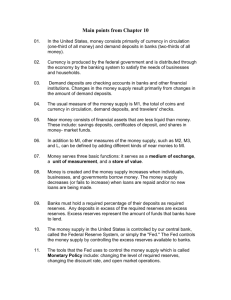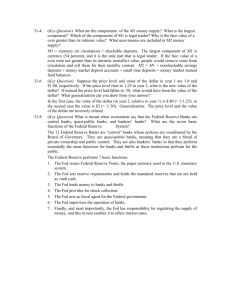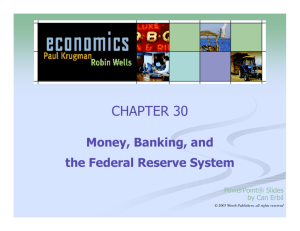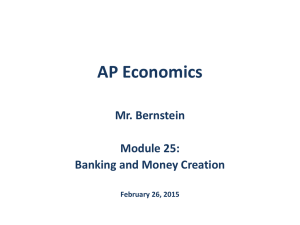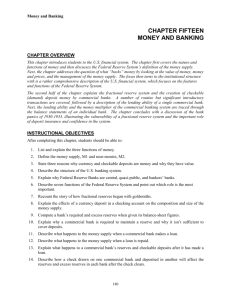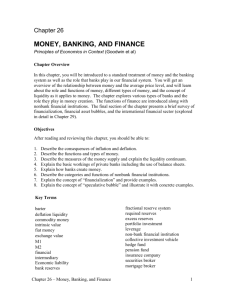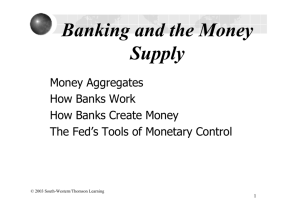Chapter 4
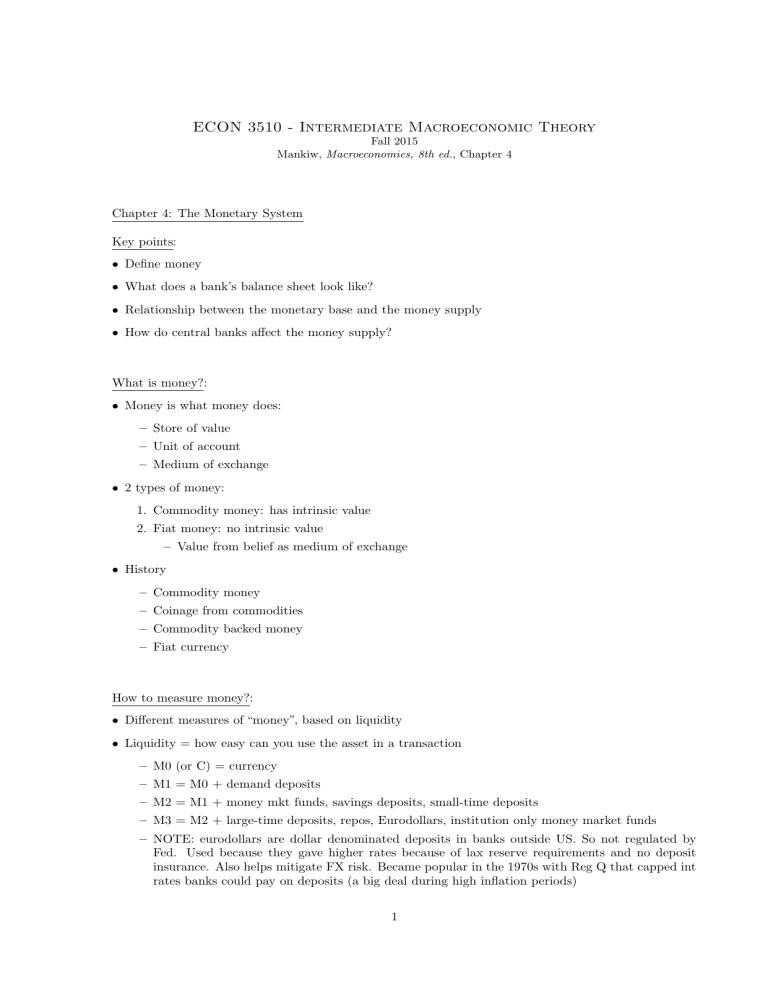
ECON 3510 - Intermediate Macroeconomic Theory
Fall 2015
Mankiw, Macroeconomics, 8th ed.
, Chapter 4
Chapter 4: The Monetary System
Key points:
• Define money
• What does a bank’s balance sheet look like?
• Relationship between the monetary base and the money supply
• How do central banks affect the money supply?
What is money?:
• Money is what money does:
– Store of value
– Unit of account
– Medium of exchange
• 2 types of money:
1. Commodity money: has intrinsic value
2. Fiat money: no intrinsic value
– Value from belief as medium of exchange
• History
– Commodity money
– Coinage from commodities
– Commodity backed money
– Fiat currency
How to measure money?:
• Different measures of “money”, based on liquidity
• Liquidity = how easy can you use the asset in a transaction
– M0 (or C) = currency
– M1 = M0 + demand deposits
– M2 = M1 + money mkt funds, savings deposits, small-time deposits
– M3 = M2 + large-time deposits, repos, Eurodollars, institution only money market funds
– NOTE: eurodollars are dollar denominated deposits in banks outside US. So not regulated by
Fed. Used because they gave higher rates because of lax reserve requirements and no deposit insurance. Also helps mitigate FX risk. Became popular in the 1970s with Reg Q that capped int rates banks could pay on deposits (a big deal during high inflation periods)
1
– others...
• Generally, we’ll define the money supply as M = C + D
– D may very depending upon measure of the money supply interested in
Banks and Money:
• 2 types of banking systems:
1. 100-percent reserve banking
– banks can’t loan out deposits
– ⇒ banks can’t affect the money supply
– → $1 in the door means C ↓ by $1 and D ↑ by $1 ⇒ ∆ M = 0
2. Fractional-reserve banking
– banks lend out some of their deposits
– ⇒ bank can affect the money supply
Fractional Reserve Banking:
• Key measure: the reserve-deposit ratio
– This is the fraction of deposits kept on reserve (i.e., sitting in the bank)
• e.g., TABLE HERE
1st Bank’s Balance Sheet
Assets Liabilities
Reserves $200 Deposits $1,000
Loans $800
– 1st Bank lent out $800 of $1,000
– $200 left in the bank
– ⇒ reserve deposit ratio =
200
1 , 000
= 0 .
2 or 20%
• How do banks create money?
– recall, M = C + D
– Before any one visited 1st Bank:
∗ C = $1000
∗ D = $0
∗ M = C + D = 1000 + 0 = 1000
– After deposit with 1st bank, but before loans made:
∗ C = $0
∗ D = $1000
∗ M = C + D = 0 + 1000 = 1000
– After loans made:
∗ C = $800
2
∗ D = $1 , 000
∗ M = C + D = 800 + 1 , 000 = 1800
∗ 1st Bank’s lending increased the money supply by $800!
• Total money creation from the banking system:
– Doesn’t stop with one bank
– Borrower’s deposit their money in other banks
– ⇒ total money creation is the sum of the money created by all of these banks/transactions
– Finding this amount:
∗ Let rr denote the reserve deposit ratio
∗ Total money created = the sum of:
∗ The original deposit = $1000
∗ + 1st Bank lending = (1 − rr ) × $1000
∗ + 2nd Bank lending = (1 − rr ) × (1 − rr ) × $1000
∗ + 3rd Bank lending = (1 − rr ) × (1 − rr ) × (1 − rr ) × $1000
∗ + ....
∗ = total money supply, M = [1 + (1 − rr ) + (1 − rr )
2
+ (1 − rr )
3
+ ...
] × $1000
| {z an infinite geometric series
}
∗ =
1 rr then
× $1000 (rule of summing geometric series is that if series is 1 + α + α
2
P
∞ i =0
α i
=
1
1 − α
. In this case, α = 1 − rr, so sum is
1
1 − (1 − rr )
=
1 rr
.)
∗ e.g., if rr = 0 .
2, as in example above, then
+ ...
and α < 1,
∗ M =
1
0 .
2
× $1
∗ = 5 × $1 , 000
, 000
∗ ⇒ money supply increases 5-fold b/c of fractional reserve banking
More Complex Banking:
• Banks don’t just make loans, but also buy financial securities
• Don’t just take deposits, but borrow
• Owner’s put up capital (owner’s equity)
• Typical balance sheet:
• TABLE HERE:
1st Bank’s Balance Sheet
Assets Liabilities
Reserves $200 Deposits $750
Loans $500 Debt $200
Securities $300 Capital $50
• Bank uses leverage - borrowed funds to support investment
• Leverage ratio = banks assets bank capital
– e.g. ratio =
$1 , 000
$50
= 20
– ⇒ $20 in assets per dollar in capital
3
∗ Remaning $19 supported from deposits and debt
• Leverage acts to amplify returns/losses
– e.g., Return on equity= ROE =
$earnings from assets
$capital
– Suppose have $1,000 in assets with a 5% return
– ⇒ $50 in earnings from assets
– If no leverage, then have $1,000 capital behind $1,000 assets
– ⇒ ROE =
50
1000
= 5%
– If leveraged 20 to 1, then have $50 capital behind $1,000 assets
– ⇒ ROE =
50
50
= 100%
– Similarly, with losses
∗ e.g., -5% loss = -$50
∗ If leveraged 20 to 1, so have $50 in capital, then all owner’s equity wiped out
∗ If losses exceed 5%, then debt holders/depositors may get hit
∗ This makes bank runs more likely on more under-capitalized banks
∗ Explain how this lead to bank runs in 2007-2009 crisis
– Think about homeownership in the Great Recession
∗ Many bought with less than 5% down. This means many leveraged 20 to 1 or higher.
∗ With a decline in home value of 5%, then someone who has just 5% equity in their home is wiped out.
∗ Average decline during 2006-2009 was 30%! So many their mortgages “underwater” (owe more on home than it’s worth)...
• Capital requirements
– Capital requirements are rules that exist to protect depositors/debtors
– They specify the amount of capital that a bank needs to hold for each dollar of assets
– The amount of capital varies by asset risk (this is where ratings agencies come in)
A model of the Money Supply:
• Monetary base = # dollars currency held by the public + reserves held by banks
– This variable is directly controlled by the central bank
– B = C + R
• Reserve-deposit ratio = rr = reserves deposits
=
R
D
• Currency-deposit ratio = cr =
C
D
• Relating M & B :
– M = C + D
– B = C + R
– ⇒ M
B
= C + D
C + R
=
C
D
C
D
+
+
D
D
R
D
– ⇒ M = cr + 1 cr + rr
| {z } m
× B
=
C
+1
D
C
D
+
R
D
= cr +1 cr + rr
4
– m ≡ the money multiplier
∗ Note: m ≥ 1
∗ We call B high powered money, because it is affected by this money multiplier
• The Money Multiplier:
– Increases as reserve/deposit ratio falls (b/c banks lending out more money)
– Increases as currency/deposit ratio falls (b/c more being deposited and able to be lent out again)
• Thus, M ↑ ...
– by the same percentage as B increases
– As cr ↓
– As rr ↓
Instruments of Monetary Policy:
• 2 main ways to affect M :
• 1) Changes to the monetary base, B
1. Open market operations
– The central bank buys/sells bonds
– If buy: The Fed gives money in the form of reserves, R , in exchange for bonds
– ⇒↑ R ⇒↑ B ⇒↑ M
2. Lend to banks
– Discount window borrowing
– → borrow reserves from Fed at set rate, called the discount rate
– → Fed controls rate to get ↑ / ↓ borrowing
– → Lower rate ⇒↑ R ⇒↑ B ⇒↑ M
– Term Auction Facility
– → Auction off a certain amount of loans to highest eligible bidder
– → ↑ R ⇒↑ B ⇒↑ M
– → This is a relatively new tool of the Fed - since 2007
• 2) Changes in the reserve-deposit ratio, rr
1. Set reserve requirement
– Fed regulations impose a minimum rr on banks
– If reserve requirement binds, then lower reserve requirement ↑ m ⇒↑ M
– Not as important right now, because banks holding lots of excess reserves
– SHOW graph with excess reserves
2. Set interest rate paid on reserves
– Fed pays interest on reserves held with them
– ↑ rate ⇒↑ rr ⇒↓ m ⇒↓ M
– This is also a new tool - Fed started paying interest on reserves in 2008
The Great Depression and the Great Recession:
5
• Note: this chapter is new to text - as is chapter 20 on the recent financial crisis. This chapter was added to help with our understanding of what happened then
• The Great Depression
– M ↓ 28%
– Blamed for severity of recession
– Critics often blame the Fed for not responding well
∗ But B ↑ 18%
∗ Problem was, cr ↑ b/c bank failures cause depositors to pull money out
∗ And rr ↑ b/c banks hold more reserves to protect against increases in loan default rates
∗ SHOW graph of home prices since 1900
∗ But why not increase B even more??
• The Great Recession
– Bank failure, loan defaults ⇒ cr ↑ , rr ↑⇒ m ↓⇒ M ↓
– Fed very active:
∗ B ↑ 288% since Aug 2008
∗ M 1 ↑ 81% since Aug 2008
∗ SHOW graphs of monetary base and M1
∗ Bernanke scholar of Great Depression - thought 2008-09 financial crisis works that that in
1929-1932 and vowed to not let Fed be too unresponsive again
6


